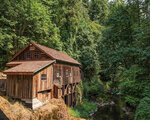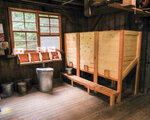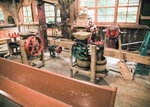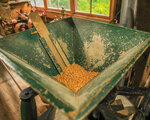



Residents are invited to enjoy fall and celebrate a big part of the area’s history at the annual Cedar Creek Grist Mill Apple Cider Pressing.
The event is the last of the season hosted by The Friends of the Cedar Creek Grist Mill, a non-profit organization that maintains the historic building near Woodland, built in 1876.
The Apple Cider Pressing will take place at 9 a.m. Saturday, Oct. 28, when grist mill volunteers will make cider and even let visitors toss in some apples, as well. Roughly 10,000 pounds of apples are pressed into apple cider during the event. For those who play an instrument, the event also hosts a bluegrass jam on the back deck.
Longtime Cedar Creek Grist Mill board member Jeffrey Berry said often during the Apple Cider Pressing event, members of the Battle Ground High School Junior Reserve Officers’ Training Corps will wash the apples and transfer them to the grist mill where four cider presses will turn the apples into cider.
“We cover the floor with wood chips to help the spillage cleanup,” Berry said. “It’s the annual mopping of the place. It smells awesome in here for a month afterwards.”
Apple cider will be sold at $5 per half gallon with Anderson Plastic in Brush Prairie donating the jugs.
Mill History
A migrant miller named George Woodham and his sons built the mill in 1876, originally calling it the Red Bird Mill. With Cedar Creek having sufficient water flow to keep it operating year-round, farmers throughout Clark County brought their grain to the mill to grind it into flour, cornmeal or livestock feed, according to the Cedar Creek Grist Mill’s website.
“This place was really late in the game to be real profitable as a grist mill,” Berry said.
In 1879, Woodham moved his equipment to Centralia. Mike Lynch bought the mill but left it sitting unused until Gustave Utter leased it in 1888. Utter built a flume and installed a Leffel turbine to create water power. The turbine is still used today, according to the website. By 1901, Utter was unable to operate the mill with a profit, so he sold it and moved on.
It wasn’t until 1909 that the mill saw action when Gorund Roslund added a shingle mill to the rear of the original structure. In 1912, one of Roslund’s son’s, Victor, converted the entire lower floor of the mill into a machine shop for the logging industry. Victor Roslund eventually made parts for the Merwin Dam on the North Fork Lewis River, Berry said.
Another son, Elmer Roslund, added a blacksmith shop on the front of the mill, and Victor Roslund used the upper floor as an apartment.
After Victor Roslund died in the late 1950s, the State Fisheries Department bought the property. With weather taking its toll on the structure, the Fort Vancouver Historical Society leased the mill in 1961 and had it registered as a historical site and replaced the rotting foundation.
By 1980, weather and vandal damage added up, and a group of local residents formed The Friends of the Cedar Creek Grist Mill, a non-profit organization, according to the website. With structural repairs and authentic replacements, the volunteers revived the structure. The flume was extended 650 feet upstream to bring water to the mill after the State Fisheries Department removed a dam on the creek, Berry said.
In 1989, in celebration of Washington State’s centennial, the non-profit organization met its goal to begin grinding wheat once again.
“The Cedar Creek Grist Mill became a working museum, showing visitors the inside workings of a grist mill of the 1876 time period,” according to the website. “It is the oldest building in the state of Washington that is still doing the job that it was built to do.”
For it to maintain its status as a working museum, volunteers come on Saturdays to demonstrate the mill in action, as well as provide visitor tours, on Saturdays. The organization stopped giving tours on Sundays because of a volunteer shortage.
“It would be awesome if we can find a couple more dedicated volunteers [to] hang out for a month or two and learn everything and then cover one day a month,” Berry said, adding people are encouraged to visit any Saturday when the mill is open and offer to volunteer. “We have a board meeting the third Tuesday of the month at 7 p.m. at Green Mountain Baptist Church, … We encourage new volunteers, if you want to meet everybody at once, [to] show up at that or show up week after week.”
The grist mill, 43907 N.E. Grist Mill Road in Woodland, is open from 1 p.m. to 4 p.m. Saturdays.
To learn more about the Cedar Creek Grist Mill, visit cedarcreekgristmill.org. The grist mill can also be found on Facebook under the Cedar Creek Grist Mill museum page.